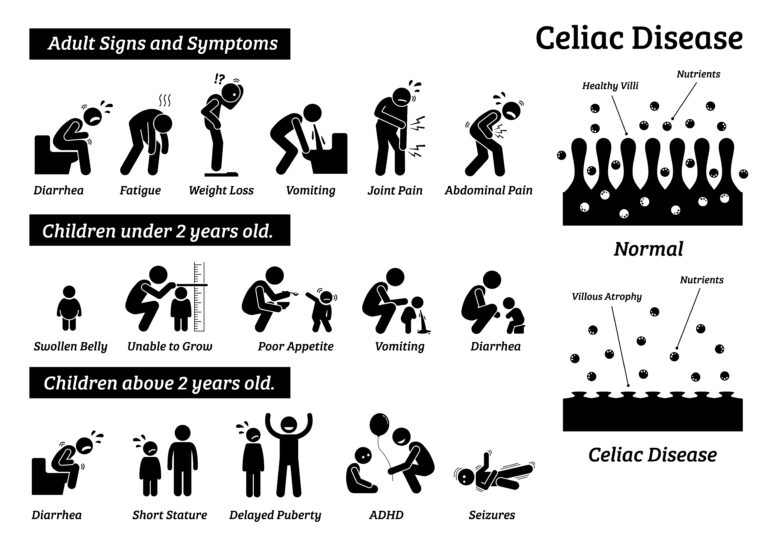Celiac Disease Is More Common Than You Think

Celiac disease often goes under diagnosed as many people chalk up their symptoms to a gluten sensitivity or intolerance. What they may not understand is that their symptoms could be pointing to an autoimmune disease that affects 1 in 100 people worldwide. Celiac disease occurs mostly in people who are genetically predisposed to the disease. So what is celiac disease? Celiac disease occurs when ingested gluten triggers an immune response to attack the small intestine. When these attacks happen, damage occurs to the small, fingerlike projections that line the small intestine. These fingerlike projections are called villi and they are responsible for nutrient absorption so when they are damaged, nutrients cannot be absorbed properly.
Unfortunately, celiac disease affects people differently, making it very difficult to properly diagnose. Not to mention, there are more than 250 symptoms that can occur anywhere in the body. Although the disease is genetic, some individuals may present with the disease as a child, but others as an adult. Other people with celiac disease may have no symptoms at all. If you have a child who is experiencing, or you yourself are experiencing, any of the symptoms below, you are encouraged to check out our At-Home Celiac Disease test kit. In addition, if you have a first degree relative who suffers from celiac disease but are not experiencing any symptoms, it is recommended that you too, check out our At-Home Celiac Disease test kit.
| Does Your Child Have Celiac Disease? | Do You Have Celiac Disease? |
|---|---|
| Digestive symptoms are more common in infants and children. Here are the most common symptoms found in children:
| The most common symptoms in adults include:
|

Although there is no cure for Celiac disease at this time, there are lifestyle changes that you can implement post diagnosis to prevent further damage to your small intestine. The only “treatment” at this time is a strict adherence to a gluten-free diet. This means avoiding foods that contain wheat, barley, rye, and filling your diet with naturally gluten-free foods such as:
- Fruits
- Vegetables
- Meat and poultry
- Fish and seafood
- Dairy
- Beans, legumes, and nuts
See the “Delicious Gluten-Free Pizza Crust” recipe below from Moon and Spoon and Yum. Although leading a gluten-free diet may seem daunting, there are many healthy and delicious options!
Ingredients
- 3 3/4 cups tapioca flour
- 1 1/2 cups mozzarella and/or parmesan cheese shredded
- 1 1/4 teaspoons sea salt
- 1 teaspoon baking powder
- 1/2 teaspoon Italian seasoning
- 1-2 garlic cloves grated or minced
- 1/2 cup melted butter
- 3 eggs
- 1 1/4 cups milk of choice I use unsweetened almond
Instructions
- Preheat oven to 350°F. Drizzle a little olive oil into three 8-9″ round and/or square cake pans or cast iron skillets. If your pan(s) of choice are not very non-stick, I recommend lining them with parchment paper. I love using my copper bake pans for this recipe.
- In a large bowl combine flour, cheese, salt, baking powder, Italian seasoning, and garlic. Stir.
- Pour in melted butter and stir again.
- Pour in eggs and milk and then stir swiftly, scraping down the sides as needed until all of the flour is combined with the milk and eggs. The batter will be quite wet.
- Divide the batter between the cake pans. I like to use an ice cream scoop to pour a scoop into each pan evenly until all batter is dispersed.
- Bake in the pre-heated oven for 15 minutes.
- Remove from the oven and top as desired.
- Turn the oven up to 400°F.
- Bake for 6 minutes longer, and then turn the broiler on and broil until the toppings are melted and turning golden (2-3 minutes).
- Remove from the oven, slice and enjoy!
Sources:
Celiac Disease Symptoms | BeyondCeliac.org
Symptoms of Celiac Disease | Celiac Disease Foundation
Delicious Gluten-Free Pizza Crust – An Easy Dough Recipe (moonandspoonandyum.com)

